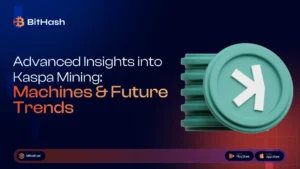In the ever-evolving world of cryptocurrency mining, ASIC miners (Application-Specific Integrated Circuits) have become the backbone of high-efficiency operations. Engineered to execute a specific hash function, most notably SHA-256, proof-of-work at blistering speeds, these machines have transformed the landscape of proof-of-work mining, especially for Bitcoin. With optimized hash rate performance and seamless integration into large-scale mining pools, ASICs have pushed the boundaries of what’s possible in digital asset production.
But as the crypto ecosystem diversifies and new coins emerge with alternative algorithms, a critical question arises: Are we stuck with SHA-256 forever, or is there room for multi-algorithm ASICs in the future? Could miners one day switch between different hash functions using the same hardware, guided by intelligent mining software that adapts to market conditions and profitability?
In this blog, we’ll explore the current dominance of SHA-256, the technical and economic challenges of building multi-algorithm ASICs, and whether the future of hash rate flexibility is closer than we think. From the role of mining pools to the evolution of proof-of-work, we’ll unpack what innovation might lie ahead and what it means for miners worldwide.
Why SHA-256 Dominates
SHA-256 is the cryptographic backbone of Bitcoin and several other major cryptocurrencies, and its dominance in the mining world is no accident. From small setups to massive industrial-scale mining operations, SHA-256 has become the gold standard for proof-of-work consensus mechanisms.
Key Reasons Behind Its Supremacy:
- SHA-256 has proven resilient against brute-force and collision attacks, making it a trusted choice for securing billions of digital assets. Its mathematical complexity ensures robust protection, even as discussions around post-quantum cryptography begin to surface.
- Hardware Optimization ASICs like the Antminer S21 and Antminer S19 have been meticulously engineered over the years to maximize SHA-256 performance. These machines routinely deliver hash rates in the hundreds of terahashes per second, offering unmatched hash power per watt. This level of optimization is difficult to replicate across other algorithms.
- Economies of Scale Major manufacturers and large-scale mining operations have invested heavily in SHA-256 infrastructure. From cooling systems to firmware and mining software, everything is tailored to extract maximum hash power from SHA-256 ASICs. This entrenched ecosystem makes it economically challenging to pivot to alternative algorithms.
- Network Hash Rate Momentum Bitcoin’s network hash rate continues to climb, driven by the deployment of increasingly powerful ASICs. As more miners join the network, the collective hash power reinforces the dominance of SHA-256, creating a self-sustaining feedback loop.
- Barriers to Diversification The sheer volume of SHA-256 ASICs deployed globally makes diversification difficult. Even GPU mining farms, which offer flexibility across multiple algorithms, struggle to match the hash power and efficiency of specialized SHA-256 hardware in large-scale mining operations.
- Infrastructure Lock-In: From power distribution to cooling systems and mining software, the infrastructure supporting SHA-256 is deeply embedded in the global mining landscape. Shifting to other algorithms would require significant reinvestment, which most operators find economically unfeasible.
As a result, SHA-256 remains the dominant hash function, not just because of its technical merits, but because of the massive hash power and capital already committed to it. Until a disruptive shift, such as the rise of post-quantum cryptography or a major change in network hash rate dynamics, SHA-256 is likely to remain the cornerstone of global mining operations.
The Case for Multi-Algorithm ASICs
As the cryptocurrency ecosystem continues to diversify, the concept of multi-algorithm ASICs, devices capable of switching between different hashing algorithms, has gained traction among miners seeking flexibility, resilience, and broader market access. Instead of being locked into a single algorithm like SHA-256, imagine a miner that could toggle between Scrypt, X11, Ethash, or even future-proof options like SHA-3-ASIC, depending on profitability, network conditions, or coin stability.
Potential Benefits
- Profit Optimization: Multi-algorithm ASICs would allow miners to chase the most profitable coin in real-time, maximizing returns across various networks. This dynamic approach could help miners better manage their cryptocurrency holdings and adapt to fluctuating market conditions.
- Resilience to Market Shifts: If a coin crashes or undergoes a major algorithm change, like Ethereum’s transition away from Ethash, miners aren’t left with obsolete hardware. This adaptability protects long-term investments and ensures that mining infrastructure remains viable and sustainable.
- Decentralization: Supporting multiple algorithms could reduce centralization around Bitcoin and SHA-256, encouraging the growth of decentralized cryptocurrency ecosystems. By distributing hash power across diverse networks, multi-algorithm ASICs could help mitigate risks associated with algorithm monopolies and single-coin dependency.
- Security Against Hash Collisions: As cryptographic research evolves, concerns about hash collision vulnerabilities in older algorithms have emerged. Multi-algorithm ASICs could pivot to a more secure SHA-3 ASIC, which offers enhanced resistance to hash collision attacks and aligns with modern cryptographic standards.
- Enhanced Cryptographic Flexibility: Future-proofing mining hardware may also involve compatibility with advanced cryptographic techniques such as elliptic curve cryptography, which underpins many wallet and transaction protocols. Multi-algorithm ASICs could be designed to support coins that integrate these technologies, expanding their utility beyond basic hashing.
- Diversified Revenue Streams: By mining across multiple coins and algorithms, operators can diversify their cryptocurrency deposits, reducing exposure to volatility in any single asset. This strategy is particularly valuable for institutional miners and large-scale operations that manage significant cryptocurrency holdings.
- Mitigation of Hash Collision Risks: With the ability to switch away from algorithms that show signs of cryptographic weakness, miners can proactively defend against potential hash collision exploits that could compromise network integrity or mining rewards.
Technical Challenges
Despite the appeal of flexibility and adaptability, building multi-algorithm ASICs is a significant undertaking. The concept sounds promising: one device capable of mining across various hash functions, such as SHA-256, Scrypt, X11, or Ethash; however, it results in a significantly increased silicon footprint, which in turn leads to higher production costs, and the engineering and economic realities are far more complex.
Hardware Complexity
Each hashing algorithm has its own unique set of requirements, including logic gate configurations, memory access patterns, and power consumption profiles. Integrating multiple algorithms into a single chip results in a significantly increased silicon footprint, which in turn leads to higher production costs, increased heat generation, and greater design complexity. Unlike single-purpose ASICs, which are optimized for a single task, multi-algorithm chips must accommodate a diverse set of operations, making them more challenging to optimize and more expensive to manufacture.
Efficiency Trade-offs
ASICs are celebrated for their specialization. A chip designed exclusively for SHA-256 can deliver exceptional hash rate and energy efficiency. However, when multiple algorithms are packed into one device, performance compromises are inevitable. The chip may deliver lower hash power per watt compared to dedicated units, reducing its competitiveness in high-stakes mining operations. This trade-off is particularly problematic in environments where network hash rate is constantly rising and miners must maximize every joule of energy.
Firmware and Switching Logic
Real-time algorithm switching isn’t just a hardware challenge; it demands sophisticated mining software and control systems. The firmware must be capable of detecting changes in profitability, managing thermal loads, and reconfiguring the chip’s internal architecture on the fly. This adds layers of complexity to both development and deployment, increasing the risk of bugs, instability, and security vulnerabilities.
Security and Cryptographic Integrity
Supporting multiple algorithms also introduces concerns around cryptographic integrity. Each algorithm has different resistance levels to threats such as hash collisions or quantum attacks. Ensuring that a multi-algorithm ASIC maintains robust security across all supported functions, particularly as technologies such as post-quantum cryptography and elliptic curve cryptography evolve, requires ongoing updates and rigorous validation.
Manufacturing and Market Viability
From a production standpoint, multi-algorithm ASICs require longer R&D cycles, more complex testing protocols, and higher upfront investment. Unless there’s strong market demand or a clear economic incentive, manufacturers are unlikely to divert resources from proven single-algorithm designs. The risk of low adoption, coupled with the challenge of competing against highly optimized SHA-256 ASICs, keeps most companies focused on what works.
Economic Realities
From a business perspective, manufacturers like Bitmain and Whatsminer prioritize ROI. Producing a multi-algorithm ASIC means:
- Higher R&D costs
- Longer development cycles
- Uncertain market demand
Unless there’s a clear economic incentive, such as a surge in multi-algorithm coins or regulatory shifts, companies are unlikely to divert resources from proven SHA-256 models.
What Could Change?
While SHA-256 remains dominant, several factors could push the industry toward multi-algorithm ASICs:
- Algorithm Rotation Protocols: New coins may adopt rotating algorithms to resist ASIC centralization, requiring adaptable hardware.
- AI-Driven Mining Optimization: Smarter firmware could allow dynamic switching between algorithms based on profitability, even within hybrid ASIC-GPU systems.
- Customizable FPGA-ASIC Hybrids: Field-programmable gate arrays (FPGAs) offer flexibility, and future ASICs might integrate FPGA-like modules for algorithm versatility.
Final Thought:
The future of multi-algorithm ASICs hinges on a delicate balance between innovation and optimization. While SHA-256 remains the king of mining algorithms, the crypto landscape is anything but static. As new coins emerge, networks evolve, and miners seek agility, the demand for versatile hardware may grow.
For now, we’re not stuck with SHA-256, but we’re deeply invested in it. Whether multi-algorithm ASICs become mainstream or remain niche will depend on how the industry values flexibility over raw power.





